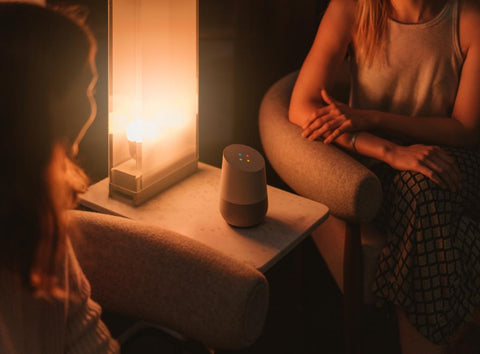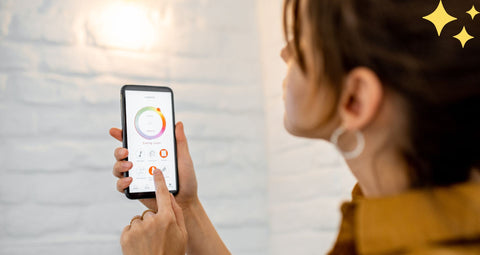Smart lights can sync with voice assistants or motion sensors, a connection that enables users to control their lighting settings remotely using a smartphone or other compatible device.
In this blog post, we will take an in-depth look at how smart lights work so that we can have a clearer idea of how they work when choosing a smart light.
What Are Smart Lights?

Smart lights, also known as connected or intelligent lighting, are advanced lighting solutions that you can control through a smartphone app, voice commands through a smart home assistant, or even automatically through sensors or schedules.
Features of Smart Lights
Learn about some features of smart lights through the following points:
Wireless Connectivity: Smart lights utilize advanced wireless communication technologies such as Wi-Fi, Bluetooth, or Zigbee to connect to a user's smartphone or other compatible devices. This wireless connectivity allows for convenient control and management of lighting systems from anywhere within the network range.
Customizable Settings: Unlike traditional light bulbs, smart lights offer a wide range of customizable features, including adjustable brightness levels, color temperatures, and even dynamic color-changing options.
Integration with Smart Home Ecosystems: One of the most compelling aspects of smart lights is their ability to seamlessly integrate with other smart home devices. By connecting smart lights with voice assistants like Amazon Alexa or Google Assistant, users can effortlessly control their lighting using voice commands or automate schedules based on specific triggers such as motion sensors or time of day.
Energy Efficiency: Many smart lights are designed to be energy-efficient, consuming less power than traditional incandescent bulbs while still providing ample illumination. Some models also feature built-in sensors that adjust brightness levels based on natural light conditions, further optimizing energy usage.
How do smart lights work?
Smart lights connect to smart home systems through wireless communication technologies (such as Wi-Fi, Bluetooth, or Zigbee) to enable remote control and automation functions. Here’s how smart lights work:
Connect to a network: Smart lights typically connect to a home Wi-Fi network or a dedicated smart home network. This allows them to communicate with other smart devices and smart controllers over wireless networks.
App Control: Smart lighting can be controlled through specific apps on your smartphone, tablet, or computer. Users can easily adjust settings such as light brightness, color, and schedule.
Voice control: Many smart lamps also support integration with smart assistants (such as Amazon Alexa, Google Assistant, or Apple HomeKit), and users can control the lights through voice commands, such as "Alexa, set the living room lights to 50% brightness."
Sensors and automation: Smart lamps usually have various built-in sensors, such as motion sensors, light sensors, etc. Users can set automation rules based on specific conditions, such as turning lights on when motion is detected or automatically dimming lights at sunset.
Remote control: Because smart lights are connected to the Internet, users can control the lights remotely from anywhere, as long as their smartphone or tablet is connected to the Internet. This provides users with greater flexibility and convenience in controlling lights while away from home.
To sum up, smart LED light use wireless communication technology and intelligent control functions to enable users to easily control and automate home lights, improving the comfort and convenience of life.
How to Set Up Your Smart Lights

If you want to set up your smart lights more conveniently, you can follow the following basic steps.
Connect a smart light fixture: Follow the instructions to connect a smart light fixture to your home Wi-Fi network or a dedicated smart home gateway. Typically connected using an app or smart home platform provided by the manufacturer.
Install the smart bulb: Follow the traditional lighting installation steps to install the smart bulb into the lamp holder, making sure the connection is secure.
Configure the app: Download the mobile app associated with the brand of light bulb you purchased, follow the instructions to register an account, and add your smart light fixtures to the app.
Set scenes and plans: Use the app to set lighting scenes and plans, such as adjusting brightness, and color temperature, and creating scheduled light-switching functions.
Connect to a smart assistant: To use the voice control function, connect the smart lamp to a smart assistant platform, such as Amazon Alexa, Google Assistant, or Apple HomeKit, and then perform voice control settings.
Testing and adjustment: Test whether the functions of smart lamps are normal, and adjust the scene and plan according to actual usage.
Summarize
By taking advantage of the capabilities of smart lights, you can set your living space to be just the way you like it. With seamless integration, customizable features, and remote access capabilities, smart lights enhance our daily lighting, providing us with convenience and flexibility.
If you want to purchase related products, please consult our Yeelight website. We can provide you with multiple styles of smart lights, including smart bulbs, smart light strips, and smart LED lights of the required styles.
FAQ
1. Will the use of smart lighting increase my energy consumption?
No, smart lights use LED technology, which consumes less energy than traditional incandescent bulbs. In addition, you can adjust the brightness and usage time through the smart control function to further save energy.
2. Can I adjust the brightness and color of smart lights at different times?
Yes, most smart lights can adjust brightness and color to suit your needs. Through the app, you can set up scheduled tasks, create scenes, or manually adjust brightness and color.
3. What is the service life of smart lights?
The service life of smart lights will vary depending on usage scenarios and environmental factors, but is typically 15,000 to 25,000 hours, which equates to a smart light used for about 3 hours a day that may last about 15 to 20 years.
Related reading: How do smart light bulbs work?


























